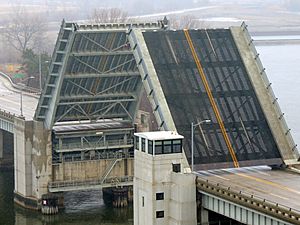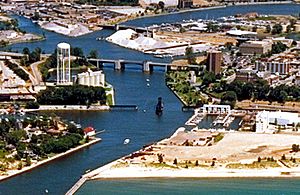Blossomland Bridge facts for kids
Quick facts for kids Blossomland Bridge |
|
|---|---|

Bridge in the raised position in 2013
|
|
| Coordinates | 42°06′44″N 86°28′40″W / 42.1122°N 86.4778°W |
| Carries | |
| Crosses | St. Joseph River |
| Locale | St. Joseph, Michigan |
| Characteristics | |
| Total length | 713 feet (217 m) |
| Width | 57.8 feet (17.6 m) |
| Longest span | 164 feet (50 m) |
| Number of spans | 7 |
| History | |
| Construction begin | 1947 |
| Construction end | 1948 |
| Construction cost | over $1.3 million |
| References | |
|
Blossomland Bridge
|
|
| Lua error in Module:Location_map at line 420: attempt to index field 'wikibase' (a nil value). | |
| NRHP reference No. | 99001576 |
| Added to NRHP | December 17, 1999 |
The Blossomland Bridge is a special bascule bridge in St. Joseph, Michigan. It carries M-63, a main road, over the St. Joseph River. A bascule bridge is a type of bridge that can lift up to let ships and boats pass underneath.
This bridge was built between 1947 and 1948. Its construction was delayed because of World War II. When it was finished, it was the longest bridge ever built by the Michigan State Highway Department. Today, the Blossomland Bridge is listed on the National Register of Historic Places. This means it is recognized as an important historical site.
Contents
History of the Blossomland Bridge
Why a New Bridge Was Needed
Before the Blossomland Bridge, there was a lot of traffic in St. Joseph and Benton Harbor. The old bridge that carried the road often broke down. This made the traffic problems even worse.
Because the St. Joseph River was used by steamboats, a new bridge was needed that could open. This led to the idea of building a bascule bridge. Plans for the new bridge started in the early 1940s. However, building had to wait until after World War II ended. Even with some shortages after the war, the Blossomland Bridge was a top priority for the state.
Building the Bridge
Engineers named Hazelet and Erdal from Chicago designed the bridge. Their plans were ready by the end of 1946. The state highway department also got some money from the government to help pay for it.
In December 1946, companies were asked to bid on building the bridge. On January 9, 1947, W. J. Meagher and Sons won the main contract. They bid about $747,000 for the job. Another company, American Bridge Company, provided and put up the steel for about $512,000.
The bridge was finished in 1948. The total cost was over $1.3 million. It was featured on the cover of a magazine called Michigan Roads and Construction that November.
Opening and Recognition
The Blossomland Bridge was officially dedicated on October 27, 1948. It was named in honor of Waldo V. Tiscornia, who was the mayor of St. Joseph. Charles Ziegler, a commissioner from the highway department, was a special guest at the opening ceremony.
The bridge officially opened to traffic on December 24, 1948. This happened after the roads leading up to it were completed. At that time, it was the longest bridge built by the state highway department.
In 1966, the bridge had some repair work done. The original railings were replaced during this time. You can still see parts of the old railings on a staircase at one corner of the bridge.
The Blossomland Bridge was added to the National Register of Historic Places on December 17, 1999. It was chosen because it is a rare type of bridge and was designed by an important engineering company. Two other bridges in Berrien County were added on the same day.
Design and Location
Where the Bridge Is Located
The Blossomland Bridge is in the northern part of downtown St. Joseph. It crosses the St. Joseph River.
How the Bridge Is Built
The bridge has seven main sections, called spans. The middle section is a special type of bascule span called a Scherzer rolling-lift. This means it rolls back on large wheels to lift up.
The main lifting part and the two sections next to it are made of strong steel beams. The other parts of the bridge are also made of steel. The main lifting section rests on strong concrete supports called piers. These piers also hold the machines that lift the bridge. The parts at the very ends of the bridge, called abutments and wing walls, are also made of concrete.
At the southern corner of the bridge, there is a staircase. This staircase goes down to where an old road and railroad tracks used to be. The metal railings on these stairs are the original ones from the bridge. There is also a special plate at the southern corner and a memorial plate on a pedestrian area at the southeastern side.



